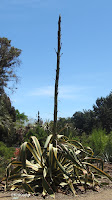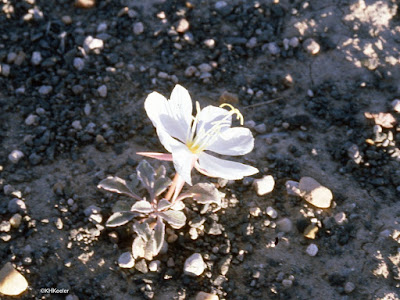Evening primroses have big flowers. If you find them open after 7 am or before 7 pm, the flowers are likely yellow. Night-flowering species are often white and close in daylight, so if you are to see them open you need to go out in twilight, wander with a flashlight or get up early. On a cloudy morning they stay open longer, but the white species tend to grow in drier places, where cloudy mornings are less common.
 |
| An evening primrose seen in southern Wyoming. |
The common evening primrose Oenothera biennis is a tall plant--to just over 3'--of roadsides and disturbed sites all over North America. The specific epithet biennis translates from Latin as biennial. Biennial means the plant lives only two years. But biennial implies more. Most biennials grow without flowering their first year, throw all the stored energy of two years into flowers and seeds and then die. That's a monocarpic--single flowering period--life. (The alternate, the life history of most plants, is to be polycarpic, flowering more than once in a lifetime, often year after year). Thus the common evening primrose is a circle of leaves on the ground, a rosette, in its first year, forming a larger circle with each new leaf. The second year, a flowering stalk shoots upward, with leaves all along the stalk. It produces yellow flowers, the flowers develop into pods with seeds and the plant dies.
 |
| This is the general look of the common evening primrose and the hairy evening primrose. |
With so many species of evening primrose beyond those two, you can stumble on wonderful flowers.
This one was along the Devil's Backbone hiking trail in Loveland, Colorado on a morning in late May. It is Howard's evening primrose, Oenothera howardii.
 |
| Howard's evening primrose, Oenothera howardii |
 |
| Howard's evening primrose, Oenothera howardii |
The plant below was seen in Arizona. It is probably Oenothera caespitosa, the dwarf evening primrose. They are perennials. The photo certainly shows how small evening primrose plants can be. The photo was taken in very early morning.
Here's another look that evening primroses have: nice stems and leaves below their big white flowers.This one was growing at lower elevations of Rocky Mountain National Park, Colorado.
 |
| evening primrose, Rocky Mountain National Park, likely crownleaf evening primrose, Oenothera coronopifolia |
And there are many yellow-flowered ones:
 |
| Missouri evening primrose, Oenothera missouriensis |
However, evening primroses are now found around the world. Looking for references on Google Scholar I find new reports of evening primroses published in the last four years for Spain, Bulgaria, Poland, Russia, Libya, the Punjab, and Anhui China, meaning the plants have escaped from cultivation and are spreading on their own across Eurasia. The species were Oenothera rosea, O. villosa, O. drummondii, and O. lacinata. The common evening primrose, Oenothera biennis, got to all those places in the 17th century, starting as a vegetable and garden flower and escaping to self-perpetuate in abandoned fields and roadsides. Here are three common evening primrose plants flowering as lawn weeds on Skeppsholmen Island, Stockholm, Sweden.
Previous post on evening primroses: Evening primroses--names and relations link

About monocarpic plants, ones that live several years, flower once and die. Century plants are a dramatic example link





Graceful written content on this blog is really useful for everyone same as I got to know. Difficult to locate relevant and useful informative blog as I found this one to get more knowledge but this is really a nice one.
ReplyDeletecopper bronze solar driveway lights outdoor
Thank you for the wonderful post. White-lined sphinx moths love the ones in my backyard, and I discovered the name on your blog.
ReplyDeleteAppreciate this blog posst
ReplyDeleteI can turn another beautiful monocarpic flower, Heracleum lanatum, into a perennial by deadheading it immediately after it blooms. (I've pinched them off with bare hands for years with no problem. If you're sensitive to the juice, use shears.) They live indefinitely if I do this, even if I let the side umbels go to seed.) Does anyone know if this works with evening primrose, Oenothera strigosa or villosa?
ReplyDeleteCool
ReplyDelete